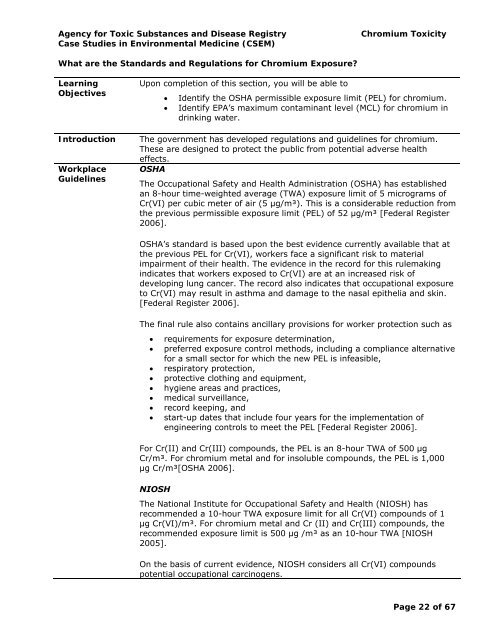(Cr) Toxicity | ATSDR - CSEM - Agency for Toxic Substances and ...
(Cr) Toxicity | ATSDR - CSEM - Agency for Toxic Substances and ...
(Cr) Toxicity | ATSDR - CSEM - Agency for Toxic Substances and ...
Create successful ePaper yourself
Turn your PDF publications into a flip-book with our unique Google optimized e-Paper software.
<strong>Agency</strong> <strong>for</strong> <strong>Toxic</strong> <strong>Substances</strong> <strong>and</strong> Disease Registry Chromium <strong><strong>Toxic</strong>ity</strong><br />
Case Studies in Environmental Medicine (<strong>CSEM</strong>)<br />
What are the St<strong>and</strong>ards <strong>and</strong> Regulations <strong>for</strong> Chromium Exposure?<br />
Learning<br />
Objectives<br />
Upon completion of this section, you will be able to<br />
• Identify the OSHA permissible exposure limit (PEL) <strong>for</strong> chromium.<br />
• Identify EPA’s maximum contaminant level (MCL) <strong>for</strong> chromium in<br />
drinking water.<br />
Introduction The government has developed regulations <strong>and</strong> guidelines <strong>for</strong> chromium.<br />
These are designed to protect the public from potential adverse health<br />
effects.<br />
Workplace<br />
Guidelines<br />
OSHA<br />
The Occupational Safety <strong>and</strong> Health Administration (OSHA) has established<br />
an 8-hour time-weighted average (TWA) exposure limit of 5 micrograms of<br />
<strong>Cr</strong>(VI) per cubic meter of air (5 μg/m³). This is a considerable reduction from<br />
the previous permissible exposure limit (PEL) of 52 μg/m³ [Federal Register<br />
2006].<br />
OSHA’s st<strong>and</strong>ard is based upon the best evidence currently available that at<br />
the previous PEL <strong>for</strong> <strong>Cr</strong>(VI), workers face a significant risk to material<br />
impairment of their health. The evidence in the record <strong>for</strong> this rulemaking<br />
indicates that workers exposed to <strong>Cr</strong>(VI) are at an increased risk of<br />
developing lung cancer. The record also indicates that occupational exposure<br />
to <strong>Cr</strong>(VI) may result in asthma <strong>and</strong> damage to the nasal epithelia <strong>and</strong> skin.<br />
[Federal Register 2006].<br />
The final rule also contains ancillary provisions <strong>for</strong> worker protection such as<br />
• requirements <strong>for</strong> exposure determination,<br />
• preferred exposure control methods, including a compliance alternative<br />
<strong>for</strong> a small sector <strong>for</strong> which the new PEL is infeasible,<br />
• respiratory protection,<br />
• protective clothing <strong>and</strong> equipment,<br />
• hygiene areas <strong>and</strong> practices,<br />
• medical surveillance,<br />
• record keeping, <strong>and</strong><br />
• start-up dates that include four years <strong>for</strong> the implementation of<br />
engineering controls to meet the PEL [Federal Register 2006].<br />
For <strong>Cr</strong>(II) <strong>and</strong> <strong>Cr</strong>(III) compounds, the PEL is an 8-hour TWA of 500 μg<br />
<strong>Cr</strong>/m³. For chromium metal <strong>and</strong> <strong>for</strong> insoluble compounds, the PEL is 1,000<br />
μg <strong>Cr</strong>/m³[OSHA 2006].<br />
NIOSH<br />
The National Institute <strong>for</strong> Occupational Safety <strong>and</strong> Health (NIOSH) has<br />
recommended a 10-hour TWA exposure limit <strong>for</strong> all <strong>Cr</strong>(VI) compounds of 1<br />
μg <strong>Cr</strong>(VI)/m³. For chromium metal <strong>and</strong> <strong>Cr</strong> (II) <strong>and</strong> <strong>Cr</strong>(III) compounds, the<br />
recommended exposure limit is 500 μg /m³ as an 10-hour TWA [NIOSH<br />
2005].<br />
On the basis of current evidence, NIOSH considers all <strong>Cr</strong>(VI) compounds<br />
potential occupational carcinogens.<br />
Page 22 of 67

















